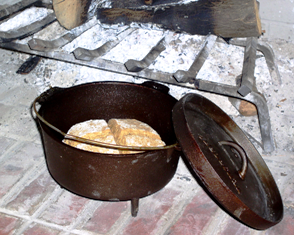"A correspondent of the Newry Telegraph gives the following receipt for making " soda bread," stating that "there is no bread to be had equal to it for invigorating the body, promoting digestion, strengthening the stomach, and improving the state of the bowels." He says, "put a pound and a half of good wheaten meal into a large bowl, mix with it two teaspoonfuls of finely-powdered salt, then take a large teaspoonful of super-carbonate of soda,% dissolve it in half a teacupful of cold water, and add it to the meal; rub up all intimately together, then pour into the bowl as much very sour buttermilk as will make the whole into soft dough (it should be as soft as could possibly be handled, and the softer the better,) form it into a cake of about an inch thickness, and put it into a flat Dutch oven or frying-pan, with some metallic cover, such as an oven-lid or griddle, apply a moderate heat underneath for twenty minutes, then lay some clear live coals upon the lid, and keep it so for half an hour longer (the under heat being allowed to fall off gradually for the last fifteen minutes,) taking off the cover occasionally to see that it does not burn. " This, he concludes, when somewhat cooled and moderately buttered, is as wholesome food as ever entered man's stomach. Wm. Clacker, Esq., of Gosford, has ordered a sample of the bread to be prepared, and a quantity of the meal to be kept for sale at the Markethill Temperance Soup and Coffee Rooms."
This same exact story was repeated in English and American newspapers and magazines over the next few years so it is possible that the Farmer's Magazine reprint may not be the first one. It is, however, the only documented copy discovered so far. (More details in my upcoming book)
A recipe by itself does not create a country-wide trend. The Famine got people’s attention, but English policy was to ship grain out of the country and import American corn and corn maize as a substitute for the normal Irish diet. expanded with bread and other items replacing the dependance on potatoes. Soda Bread was “discovered” during the famine as an inexpensive way to feed people, but corn maize was the dominant food and when that failed, soup kitchens were set up. “Indian meal” as it was called continued to be part of the diet for many years. Soda Bread did not save the population but did help it recover.
